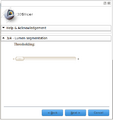Difference between revisions of "2011 Winter Project Week:StenosisDetector"
| (15 intermediate revisions by 3 users not shown) | |||
| Line 2: | Line 2: | ||
<gallery> | <gallery> | ||
Image:PW-SLC2011.png|[[2011_Winter_Project_Week#Projects|Projects List]] | Image:PW-SLC2011.png|[[2011_Winter_Project_Week#Projects|Projects List]] | ||
| − | Image: | + | Image:step1.png|StensosisDetector Step1 |
| − | Image: | + | Image:step2.png|StensosisDetector Step2 |
| + | Image:step3.png|StensosisDetector Step3 | ||
| + | Image:step4.png|StensosisDetector Step4 | ||
| + | Image:step5.png|StensosisDetector Step5 | ||
</gallery> | </gallery> | ||
| − | |||
| − | |||
| − | |||
| − | |||
| − | |||
| − | |||
| − | |||
==Key Investigators== | ==Key Investigators== | ||
| − | * | + | * University of Heidelberg, Germany: Suares Tamekue |
| − | * | + | * UPenn: Daniel Haehn |
| + | * [http://www.orobix.com Orobix], Italy: Luca Antiga | ||
| + | * SPL: Ron Kikinis | ||
<div style="margin: 20px;"> | <div style="margin: 20px;"> | ||
| Line 21: | Line 19: | ||
<h3>Objective</h3> | <h3>Objective</h3> | ||
| − | We are developing a stenosis detector | + | We are developing a stenosis detector based on VMTK in Slicer 4. The goal is to be able to visualize stenosis after a vessel segmentation using a wizard-based interface. |
| Line 34: | Line 32: | ||
<h3>Approach, Plan</h3> | <h3>Approach, Plan</h3> | ||
| − | Our approach for | + | Our approach for developing the stenosis detector is: first vessel enhancement, level-set segmentation, network extraction and then quantification and visualization of stenosis. |
| − | + | The tool will be evaluated on datasets. | |
</div> | </div> | ||
| Line 43: | Line 41: | ||
<h3>Progress</h3> | <h3>Progress</h3> | ||
| − | + | A prototyp of the graphical user interface has been designed and implemented. | |
| + | |||
| + | '''Project Week Update:''' | ||
| + | The week was very productive. We got a lot of feedback from the Kitware guys. Specially on the wizard interface which is based on the CTK library. We also had to clarify an issue concerning the area of the wizard content and the way the different wizard steps interact with each other and with the logic. | ||
| + | |||
| Line 59: | Line 61: | ||
##Built-in | ##Built-in | ||
##Extension -- commandline | ##Extension -- commandline | ||
| − | ##Extension -- loadable | + | ##Extension -- loadable [X] |
#Other (Please specify) | #Other (Please specify) | ||
==References== | ==References== | ||
| − | * | + | * Antiga L, Piccinelli M, Botti L, Ene-Iordache B, Remuzzi A and Steinman DA. An image-based modeling framework for patient-specific computational hemodynamics. Medical and Biological Engineering and Computing, 46: 1097-1112, Nov 2008. |
| − | * | + | * D. Hähn. Integration of the vascular modeling toolkit in 3d slicer. SPL, 04 2009. Available online at http://www.spl.harvard.edu/publications/item/view/1728. |
| − | * | + | * D. Hähn. Centerline Extraction of Coronary Arteries in 3D Slicer using VMTK based Tools. Master's Thesis. Department of Medical Informatics, University of Heidelberg, Germany. Feb 2010. |
| − | * | + | * Piccinelli M, Veneziani A, Steinman DA, Remuzzi A, Antiga L (2009) A framework for geometric analysis of vascular structures: applications to cerebral aneurysms. IEEE Trans Med Imaging. In press. |
| − | |||
</div> | </div> | ||
Latest revision as of 17:22, 14 January 2011
Home < 2011 Winter Project Week:StenosisDetectorKey Investigators
- University of Heidelberg, Germany: Suares Tamekue
- UPenn: Daniel Haehn
- Orobix, Italy: Luca Antiga
- SPL: Ron Kikinis
Objective
We are developing a stenosis detector based on VMTK in Slicer 4. The goal is to be able to visualize stenosis after a vessel segmentation using a wizard-based interface.
Approach, Plan
Our approach for developing the stenosis detector is: first vessel enhancement, level-set segmentation, network extraction and then quantification and visualization of stenosis.
The tool will be evaluated on datasets.
Progress
A prototyp of the graphical user interface has been designed and implemented.
Project Week Update: The week was very productive. We got a lot of feedback from the Kitware guys. Specially on the wizard interface which is based on the CTK library. We also had to clarify an issue concerning the area of the wizard content and the way the different wizard steps interact with each other and with the logic.
Delivery Mechanism
This work will be delivered to the NA-MIC Kit as a (please select the appropriate options by noting YES against them below)
- ITK Module
- Slicer Module
- Built-in
- Extension -- commandline
- Extension -- loadable [X]
- Other (Please specify)
References
- Antiga L, Piccinelli M, Botti L, Ene-Iordache B, Remuzzi A and Steinman DA. An image-based modeling framework for patient-specific computational hemodynamics. Medical and Biological Engineering and Computing, 46: 1097-1112, Nov 2008.
- D. Hähn. Integration of the vascular modeling toolkit in 3d slicer. SPL, 04 2009. Available online at http://www.spl.harvard.edu/publications/item/view/1728.
- D. Hähn. Centerline Extraction of Coronary Arteries in 3D Slicer using VMTK based Tools. Master's Thesis. Department of Medical Informatics, University of Heidelberg, Germany. Feb 2010.
- Piccinelli M, Veneziani A, Steinman DA, Remuzzi A, Antiga L (2009) A framework for geometric analysis of vascular structures: applications to cerebral aneurysms. IEEE Trans Med Imaging. In press.





